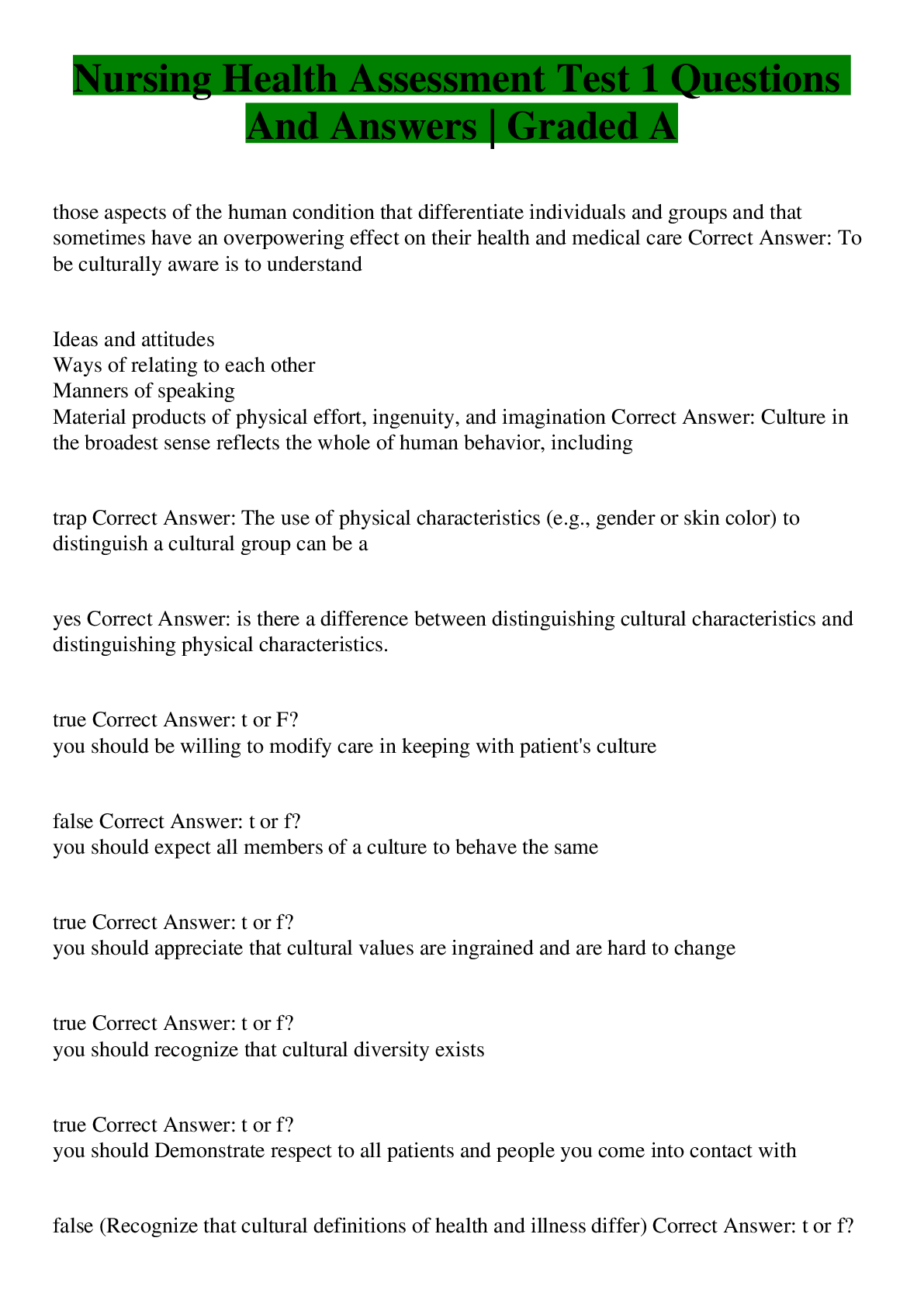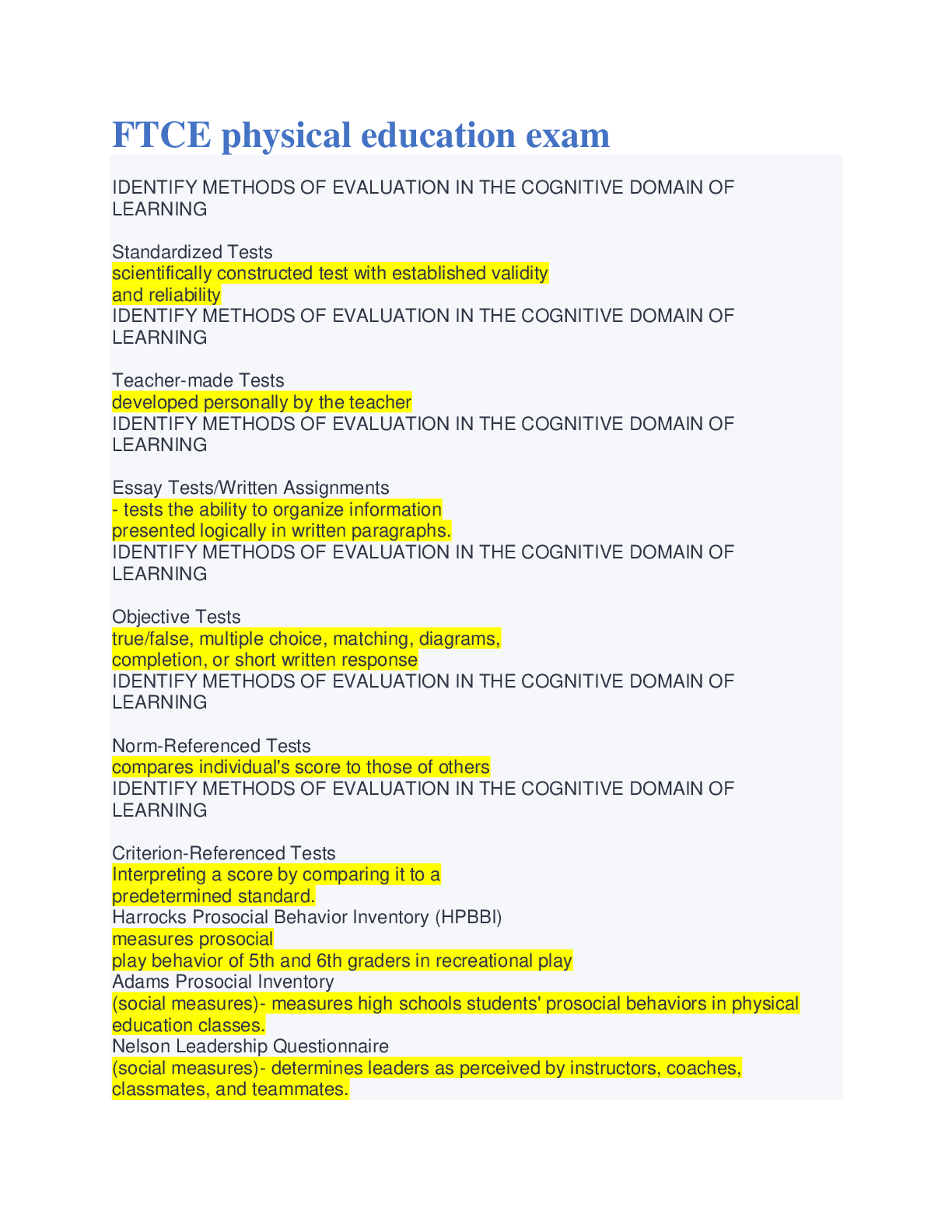Health Care > EXAM > Nursing Health Assessment Test 1 Questions And Answers | Graded A (All)
Nursing Health Assessment Test 1 Questions And Answers | Graded A
Document Content and Description Below
Nursing Health Assessment Test 1 Questions And Answers | Graded A those aspects of the human condition that differentiate individuals and groups and that sometimes have an overpowering effect on th... eir health and medical care Correct Answer: To be culturally aware is to understand Ideas and attitudes Ways of relating to each other Manners of speaking Material products of physical effort, ingenuity, and imagination Correct Answer: Culture in the broadest sense reflects the whole of human behavior, including trap Correct Answer: The use of physical characteristics (e.g., gender or skin color) to distinguish a cultural group can be a yes Correct Answer: is there a difference between distinguishing cultural characteristics and distinguishing physical characteristics. true Correct Answer: t or F? you should be willing to modify care in keeping with patient's culture false Correct Answer: t or f? you should expect all members of a culture to behave the same true Correct Answer: t or f? you should appreciate that cultural values are ingrained and are hard to change true Correct Answer: t or f? you should recognize that cultural diversity exists true Correct Answer: t or f? you should Demonstrate respect to all patients and people you come into contact with false (Recognize that cultural definitions of health and illness differ) Correct Answer: t or f? you should assume that all cultural definition of health and illness are the same acculturation Correct Answer: Process of accommodating to another culture culture Correct Answer: Integrated system of shared values custom Correct Answer: Habitual activity of a group or subgroup enculturation Correct Answer: Process of assuming the traits and behaviors of a given culture ethnocentrism Correct Answer: Belief in the superiority of one's own culture with disdain for others ethnos (ethnic group) Correct Answer: Group of same race or nationality with a common culture and traits minority Correct Answer: Group differentiated from the majority population with regard to religion, race, or ethnic origin norm Correct Answer: Prescribed standard of allowable behavior within a group race Correct Answer: Physical differentiator based on a common heredity rite Correct Answer: Prescribed, formal, customary observance ritual Correct Answer: Stereotypical behavior regulating religious, social, and professional behaviors stereotype Correct Answer: Simplified, inflexible conception of the members of a group subculture Correct Answer: Subgroup having distinctive traits that differentiate it from the larger culture values Correct Answer: Ideals, customs, institutions, and behaviors within a group for which the members have a respectful regard sensitive Correct Answer: Being ______ to cultural differences that may exist between you and the patient can help avoid miscommunication life long Correct Answer: developing cultural competency is a ____ process understand, respect Correct Answer: The ability to ______ and _____ differences and to allow for the blurring of professional borders is a measure of one's ability to form reinforcing relationships with other health care professionals and to care for a wide range of individuals. illness Correct Answer: Health care providers must consider the impact of an _____―the biologic, emotional, and cultural aspects―or else fail to offer complete care communication Correct Answer: The use of speech, body language, and space verbally, nonverbally Correct Answer: Communication and culture are interrelated, particularly in the way feelings are expressed ____ and ______ paradigm Correct Answer: Patients have a view of health and illness, and an approach to cure shaped by a cultural _____ scientific Correct Answer: Patients with a "____ view" are more comfortable with Western medical care holistic Correct Answer: Patients with a ____ or natural approach may be at odds with Western medical care family, social Correct Answer: ___ structure and the ___ organizations to which a patient belongs are among many imprinting and constraining cultural forces in a person's life. yes Correct Answer: can one type of already known behavior predict another type of behavior in a patient? their own terms Correct Answer: culturally speaking, should you meet a patient on their own terms or make them meet on your terms? cultural knowledge Correct Answer: The process of seeking and obtaining a sound educational base about culturally and ethnically diverse groups is: patient centered model Correct Answer: In the United States, the prevailing treatment model used by health professionals is: the patient history and physical examination Correct Answer: what is at the heart of the diagnostic and treatment process? misinterpretations and misperceptions Correct Answer: To prevent ______and _______ during the history and interviewing process, you must make every effort to sense the world of the patient as that patient sees it. Discover information leading to diagnosis and management. Provide information about diagnosis. Negotiate and share in health care management. Counsel about disease prevention. Correct Answer: goals of the history and interviewing process: each person is their own person Correct Answer: autonomy do good for the patient Correct Answer: beneficence do no harm to the patient Correct Answer: Nonmaleficence utilitarianism Correct Answer: Appropriate use of resources for the greater good deontologic imperatives Correct Answer: Care delivered according to traditions and in cultural contexts Courtesy Comfort Connection Confirmation Confidentiality Correct Answer: Establishing a positive patient relationship depends on communication built on: open ended question Correct Answer: question that allows patient discretion about the extent of an answer direct question Correct Answer: question that seeks specific information leading question Correct Answer: question that may limit the information provided to what the patient thinks you want to know teaching Correct Answer: ____ is very important for disease prevention facilitate reflect clarify empathize confront interpret Correct Answer: how to enhance patient responses facilitate Correct Answer: communication technique that encourages the patient to say more empathizing Correct Answer: communication technique that shows understanding and acceptance interpret Correct Answer: communication technique where you repeat what you heard to confirm the patient's meaning confront Correct Answer: communication technique where you address disturbing patient behavior history Correct Answer: Taking a ____ usually begins your relationship with the patient Comfort for all involved Removal of physical barriers Good lighting Privacy Relative quiet Unobtrusive access to clock Correct Answer: preferred setting for the interview to obtain a history problems Correct Answer: during the patient history, identify those matters the patient defines as reliability Correct Answer: during the patient history, establish a sense of the patient's ____ [Show More]
Last updated: 2 years ago
Preview 1 out of 46 pages

Buy this document to get the full access instantly
Instant Download Access after purchase
Buy NowInstant download
We Accept:

Reviews( 0 )
$15.00
Can't find what you want? Try our AI powered Search
Document information
Connected school, study & course
About the document
Uploaded On
Sep 19, 2022
Number of pages
46
Written in
Additional information
This document has been written for:
Uploaded
Sep 19, 2022
Downloads
0
Views
58


























